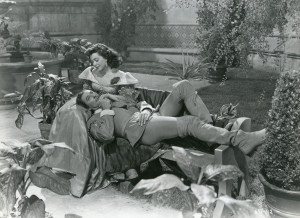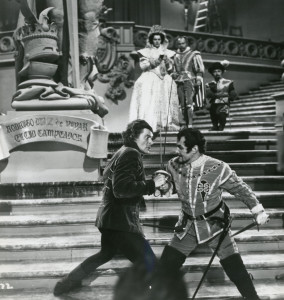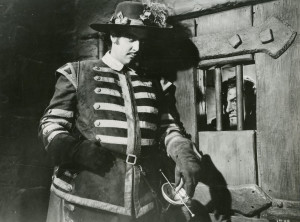by Barb Lentz.
The five movies Bob provided me from which to choose were these:
Adventures of Don Juan (1948)
The China Syndrome (1979)
Good Morning, Miss Dove (1955)
Long Day’s Journey Into Night (1962)
The Public Enemy (1931)
Another difficult decision was made easier by the fact that only one of this quintet looks to be light-hearted, and because we have yet to see an Errol Flynn adventure. The others certainly look interesting, but I am more interested in seeing Mr. Flynn for the first time, or at least the first time in a long time.

Adventures of Don Juan tells the story of the legendary Lothario, although the legend is different from what I expected. Don Juan (Errol Flynn) is a handsome Spanish nobleman who travels the world in pursuit of happiness, which he finds in the forms of beautiful women. An embarrassment sends him back to Spain for the first time in many years, and he doesn’t like the injustice that he witnesses there. He meets the Spanish queen (Viveca Lindfors) and loses his heart for the first time — not to her beauty but for her selfless dedication to her adopted people (she is originally Austrian).
The Count de Lorca (Robert Douglas) desires power, and war, and is using his influence over the weak king (Romney Brent) to attain his goals. de Lorca will let nothing stand in his way, whether it be a queen or the return of Don Juan. It takes time for things to come together but when they do, it is Don Juan and his friends and fencing students against de Lorca and the palace guards, with the rule of Spain hanging in the balance. Thankfully Don Juan is as expert a swordsman as he is a kisser, so Spain remains in good hands.
This movie was obviously quite a production; the costumes are tremendous! I noticed that Don Juan usually wore a cape, and I wondered if that were the norm. The color film is gorgeous; the sets, especially that of the palace, are beautiful; it looks as though the budget was well spent. Nothing looks cheap or artificial — it is all quite convincing. Even Count de Polan’s ring was amazing — it looks bigger than a Super Bowl ring!

I appreciated that Don Juan preferred to settle matters of controversy without resorting to violence. He tries to talk two angry husbands out of lancing him before defending himself with honor, and without hurting them. I also found it interesting that it is the women who often chase him; he is pursued by one married woman who proclaims herself “unattached” because she prefers not to attach herself to her husband, and another who is to be married on the morrow, but who wants one final fling of passion. In both cases he sighs with regret that he has been so deceived. If this is what he continually encounters, perhaps Don Juan’s reputation is not so thoroughly justified.
The movie also seems contemporary and relevant, with a timeless quality. It isn’t dated, and carries a noble message that moves its more exploitive aspects to the background. With its beautiful color, magnificent costumes, serious message and emphasis on action, the movie doesn’t seem old at all.
My top five moments of the movie are:
1. The way the first scene sets the tone to follow. The first romantic encounter, between Don Juan and Catherine (Mary Stuart) is lighthearted and fun. He toys with her emotions, but she wishes him to, preferring to spend time alone with him rather than her grouse-hunting husband. The rest of the film follows suit, keeping things light and airy until the governmental intrigue takes control of the story. In some ways this reminded me of The Princess Bride!
2. Errol Flynn’s presence and athleticism. He may have been nearly forty, but the man still had it going on. It’s easy to see why he was a matinee idol, adored by millions of women, and how men could be jealous of him. Not every actor can look convincing in tights and rapier, but Errol Flynn could do it blindfolded.
3. Don Sebastian (Jerry Austin). What an interesting character! At first I didn’t know what to think of him, and he was rather annoying because he was rude. But then you could see that he was devoted to the queen, and even the king liked having him around. And when Don Juan gets into trouble, it is Don Sebastian who supports his pal, turning to activism to save the throne. For me, Don Sebastian is the heart of the story.

4. The school fencing scene. There are several fencing scenes and sword fights throughout the story, but I was most impressed by the school’s recital, when a bunch of students perform drills in formation. It is very impressive, and kind of scary; I am always afraid that someone will accidentally stick someone else. Of course, that probably wouldn’t make the final cut of the film.
5. The insight behind international diplomacy. It was interesting that marriage was considered one of the best ways to cement relations between countries, even when the prospective bride and groom had never met! This Europe of the early seventeenth century is much different than the one we know today, and the historical allusions are compelling.
Is Adventures of Don Juan a classic? I think it probably is. The production is top-notch, looking just as good today as it must have looked then. The script is very good, taking an historical legend and twisting things around to surprise expectations and create a serious story with noble intentions, all camouflaged within a comic adventure. It isn’t what I expected at all; it’s better. Errol Flynn is excellent in the part, perfectly cast, still able to fence with aplomb and skill. I really liked the queen’s perspective on her duties, especially as she was not a natural-born Spanish citizen. It didn’t matter. Her duty is to her people, and she was willing to die to protect them. That’s what finally gets across to Don Juan, making him a better person. Her selflessness inspires him to offer everything he has, for the people of Spain. If only our own politicians were so selfless. Alas, it’s only a movie.
BRL 6 March 2016.
Adventures of Don Juan (December 1, 1948) Warner Bros.
Directed by Vincent Sherman. Produced by Jerry Wald.
Screenplay by George Oppenheimer and Harry Kurnitz.
From a story by Herbert Dalmas.
Uncredited Writers: William Faulkner, Max Brand and Robert Florey.
Principal Cast (character, performer):
Don Juan de Maraña Errol Flynn
Queen Margaret Viveca Lindfors
Duke de Lorca Robert Douglas
Leporello Alan Hale
King Phillip III Romney Brent
Donna Elena Ann Rutherford
Don José Robert Warwick
Don Sebastian Jerry Austin
Don Rodrigo Douglas Kennedy
Donna Carlotta Jean Shepherd
Catherine Mary Stuart
Lady Diana Helen Westcott
Duenna Una O’Connor
Captain Alvarez Raymond Burr
110 minutes. Technicolor. Not Rated.
